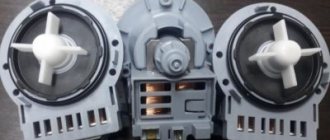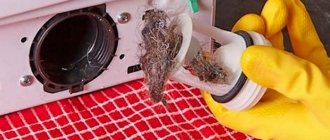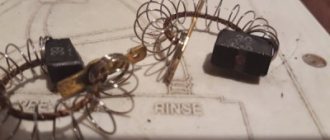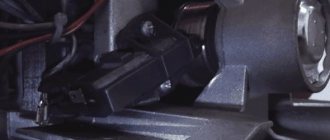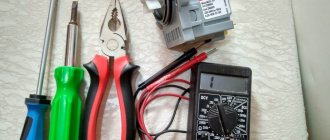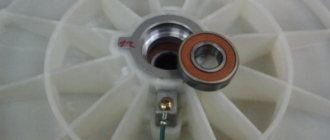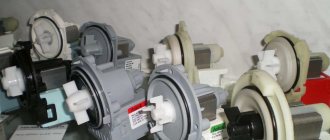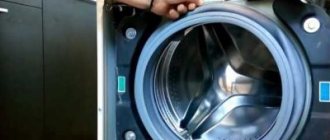Partial or complete blocking of the process of draining water from the drum indicates that the drain pump has failed.
Along with external signs of a breakdown (water in the tank after washing, a hum during the draining process), the Bosch washing machine signals a malfunction of the drain pump with error F03.
Having studied in detail the issue of replacing and repairing a faulty pump, you can independently return the Bosch washing machine to working condition.
What is this part, why is it needed?
The drain pump (pump) is one of the key elements of the internal structure of a Bosch washing machine, the main function of which is to remove liquid from the drum .
The application is activated at all stages of the working cycle: washing, rinsing, spinning. At the end of each stage, the control module receives a signal about the need to drain the water, after which the pump is turned on. By pumping out the waste liquid, the pump prepares the washing machine for the next stage of the running operating cycle.
Principle of operation
The drain pump of a Bosch washing machine consists of two parts: a low-power electric motor (enclosed in a sealed housing) on the shaft of which an impeller and volutes in the form of a plastic pipe are fixed.
On one side the snail is attached to the pump body, on the other side it is connected by a pipe to the tank of the washing machine.
As soon as the control module sends a signal, the process of pumping water out of the drum begins : the rotation of the pump impeller starts, which pumps out waste liquid from the drum of the washing machine through a pipe.
During the draining process, the water passes through a filter element located in the pump volute (protects against the entry of small debris), after which it flows through the drain hose into the sewer pipe of the house. The pumping process continues until the water level sensor in the tank (pressure switch) transmits a signal to the control module that the drum is completely empty.
Diagnostics
Repairing a washing machine pump with your own hands involves a preliminary check of the unit:
- Inspect the impeller and body of the device, while removing any debris wound around the shaft. Cracks or broken blades on the impeller are not allowed - this leads to imbalance of the rotor.
- Rotate the shaft by hand; the rotor axis should not dangle in the bearing supports or cling to the stator housing. Small jerks during rotation are allowed due to the rotor turning between the permanent magnets.
- Connect a test device to the connectors to determine the rated resistance and integrity of the windings. If the multimeter shows a break, then such a motor cannot be repaired. It is necessary to replace the unit with an original part and a pump produced by another manufacturer.
- If the windings are in good condition, it is necessary to start the motor by connecting it directly to the AC mains. If the engine is running, then you should check the electronics of the washing machine (for example, the control controller, level sensor or connecting cables).
Where is it located in the Bosch washing machine?
In Bosch washing machines, the drain filter can be found behind the front panel, at the bottom of the case, under the tank.
To remove the faulty pump, it is necessary to partially dismantle the housing:
- Pull out the detergent dispenser.
- Open the hatch door and carefully pry off the thin metal clamp holding the rubber seal with a flat screwdriver.
- Tuck the cuff inside the washing machine drum.
- Unscrew the fasteners holding the UBL.
- Open the small hatch at the bottom of the washing machine and unscrew the drain filter (clean if necessary).
- At the top of the case, remove the fasteners for the cover and control panel.
- Unscrew the fasteners around the perimeter of the front panel and remove it from the body.
Behind the front panel, under the tank, access to the pump is available.
How to find a pump and how does it work?
The pump is activated for every wash, otherwise the machine would remain standing with a full tank of water. But the pump does not “turn on” immediately, but at the final stages of the cycle. To understand the principle of operation of the drainage device, you will have to follow the entire “washing” process.
The washing machine starts working by turning on the power, selecting the appropriate mode, setting the remaining settings and pressing the “Start/Start” button. The control board receives the signal and starts the system:
- the solenoid valve opens;
- water from the water supply under pressure enters the machine;
- the pressure switch measures the specified amount of water, controlling the filling;
- water “passes” through the pipes and enters the powder receptacle, where it is mixed with detergent;
- soapy water is already poured through the main pipe into the tank;
- The laundry loaded into the drum is immersed in a soap solution;
- The machine starts to wash.
The pump is “turned on” in the process at the final stages of washing - rinsing, spinning and draining. With its help, waste water is pumped out of the tank, completely or in portions. The pump only stops working when soaking. The control board activates the drainage system - the module gives a command to drain water from the tank. Pumping liquid into the sewer occurs as follows:
- the pump turns on, the impeller spins up;
- water leaves the tank through the hose connecting the tank to the pump;
- the liquid “flows” through the hose through the garbage filter, where large debris, some lint and hair are retained;
- water enters the pump and passes through it;
- the liquid is discharged through the drain hose into the central sewer system;
- the pressure switch monitors the emptying of the tank;
- as soon as the tank becomes empty, the board gives the pump a signal to turn off.
For unhindered drainage, the water is located in the lower part of the housing. It is important that the drainage hose is fixed according to the instructions - above the level of the washing tank, otherwise the machine will empty by gravity or pick up sewage from the sewer.
According to the instructions, the drain hose must be raised 60-80 cm from the floor, otherwise the water will leave the tank by gravity.
The electric pump, like the entire drainage system, is located below, under the washing tub. The pump is fixed to the plastic volute with 2-4 screws. Getting to the device is easy: just put the washer on its side, disconnect the tray and look under the bottom.
Possible faults
The root cause of failure of the drain pump in a washing machine is small debris sticking to the pump impeller.
In order to fix the problem yourself, you need to unscrew the drain filter (located in the lower part of the housing) and manually turn the blades through the opened hatch .
If the impeller does not rotate, it is necessary to dismantle the pump and clean the blades of accumulated debris. The second reason why the drain pump will outgrow its functions is that the pump motor has failed. A multimeter will help you check if this is the case.
Algorithm of actions:
- switch the tester to “Resistance” mode;
- Apply the multimeter probes to the pump contacts.
Zero readings indicate a short circuit, and readings exceeding 260 ohms indicate a fault in the stator winding. Identified malfunctions of the pump motor are indications for a complete replacement of the drain pump.
Signs and causes of breakdowns
Before you begin repairs or go to the store to buy a pump, you need to carry out diagnostics. After determining the degree of complexity of the problem, a method for solving it is chosen.
The washing machine pump, along with the engine, experiences high loads, so it is often the first to fail.
There may be several signs of its malfunction. They appear simultaneously or separately.
The following signs are considered the most typical:
- Lack of response to specified programs.
- Loud noise made by the motor when pumping and draining water.
- Insufficient water volume in the tank.
- The machine turns off when the tank is filled with water.
The causes of failure are also varied. They are easily identified during diagnosis. The verification is carried out in stages. First, check the drain filter, which can become clogged if small objects get into the drum.
In most washing machine models, cleaning the filter is not difficult. This procedure is available to any owner who cares about the condition of household appliances in their home
As a result of clogging, it cannot cope with its work, the pump begins to make a lot of noise, and if measures are not taken in a timely manner, it fails. Cleaning the filter will help correct the situation.
Cleaning the filter, as a preventive measure, should be carried out regularly. If you don't do this, the problem may get worse. Failure of the pump is also associated with improper maintenance.
If the filter is in order, check the impeller by turning the blades. This is done manually. Jamming indicates that small objects have gotten into it.
The next step is to check the drain hose, which may contain small objects or stagnant water. For a more thorough inspection, the pump must be dismantled.
To inspect and clean the pump, you need to unscrew the fasteners and remove the device. Depending on the brand and model of the washing machine, the pump is released from the volute by unscrewing the fixing bolts or by rotating movements
Problems can be not only mechanical, but also due to failure of electronics: disconnected contacts, malfunction of sensors, etc. To identify the problem area, it is necessary to “ring” the wires.
The pump removed from the car is disassembled, cleaned and inspected. The procedure, which does not take much time, is recommended to be carried out every three months of active use of the device
The most common causes of failure also include wear of the motor bushings, short circuit and winding breakage. Calling a technician to your home and diagnostics during the warranty period are usually performed free of charge.
Service codes can also indicate pump failure. Each manufacturer has their own. You can familiarize yourself with them by studying the instructions for the device or on the manufacturer’s official website.
In addition to codes, the user will find other useful maintenance information. The cost of the pump, its replacement and repair depends on the make and model of the machine, as well as the type of breakdown.
How to change?
Replacing a faulty drain pump takes place in two stages: dismantling the faulty element and installing a new unit.
How to remove?
Before starting repair work, the washing machine must be properly prepared:
- disconnect from the sewer system,
- close the filler valve,
- Pull the power cord plug out of the socket.
To ensure that nothing interferes with the work, the household appliance is pulled away from the wall and placed on a flat, stable surface.
Next, you can begin the process of dismantling the faulty pump:
Carefully disconnect the wiring.- Loosen the clamps of the pipes connecting the pump to the tank and the drain hose.
- Unscrew the screws holding the volute with the filter.
- Gently pressing the latch with a screwdriver, turning the pump relative to the volute, remove it from the body of the washing machine.
A video (photo) recording the process of dismantling a faulty pump will help when installing a new element.
Installing a new sump pump
to install a new pump that is suitable in size, mounting method and other technical characteristics :
- install a new pump in place of the dismantled element;
- fix the pump with bolts;
- we connect the terminals with the wiring (in order not to make a mistake, we check with the previously made notes);
- Having previously checked the drain pipe and hose for blockages, we connect them to the pump volute and securely secure the connections with metal clamps.
After the drain pump is connected, the washing machine body is assembled in the reverse order, the household appliance is connected to the electricity network, water supply and sewerage, and a test wash is started.
Video instructions for replacing the drain pump in a Bosch washing machine:
Types of pumps in a washing machine
Washing machine repair specialists claim that the original factory pump, subject to normal operation, lasts on average at least 10 years. Premature problems can arise due to lack of proper and timely care of the part, as well as simple clogging with small metal debris and various technical impurities in the water.
In some cases, the pump can be repaired, but sometimes it has to be replaced completely. Then the question arises of choosing a suitable pump. It should be approached with all responsibility, since the complexity of the installation and further operation of the equipment depend on it.
There are more than 50 types of pumps in automatic washing machines. For convenience, they can all be divided into two main types:
- drain - used in budget or outdated versions of machines. A simple mechanism drains water into the drain after each wash cycle;
- circulating - they supply water to the washing zone and circulate it along a closed path in only one direction. Most often, they work in tandem with a conventional pump to increase efficiency. This significantly improves washing efficiency.
A more detailed classification is considered in accordance with the following characteristics:
- fastening method - there are options with latches, screws, and combined, when the previous two types are combined;
- according to the characteristics of the contact connections - there are pumps with terminals that go in the opposite direction from the impeller, behind it and “under the chip”. In the latter version, the connector has a rectangular shape, and the connections are parallel to each other;
- power - the average value ranges from 15 to 100 W. If there is insufficient power, the device is not able to perform the job fully. Most models have a power of 34-40 W. In old units, high-power pumps were very large and costly to manufacture, but modern pumps with higher power are distinguished by their completely small sizes;
- number of branches - standard or branched. The latter is a kind of tee, one outlet is directed to the sewer, the other to the sink, and the third is connected to the washing machine. For residents of multi-storey buildings, a siphon with a check valve is considered a good option. It blocks the return of liquid to the machine if the drain hose is clogged;
- shape and size - more modern varieties are compact and well thought out. They take up very little space while maintaining excellent functionality. For example, the now popular powerful synchronous pumps with a magnetic rotor are very small in size.
The question of the manufacturer remains no less important. The highest quality and most modern pumps are produced by Italian brands Askoll and Plaset. Their products are used in more than half of all washing machines produced in the world. Besides these, Mainox, Hanning, Artiko and CopreciGre are also well known.
Undoubtedly, it is best to give preference in choosing a complete analogue of the original pump. It will fully comply with the technical parameters of the device and will not cause additional problems when connecting. It will be enough to simply restore all connections as they were before the intervention.
Operating rules
In order to operate the washing machine for as long as possible without repairing (replacing) the drain pump, you must follow certain rules:
- When connecting yourself, carefully ensure that the end of the drain hose is located at least 50 cm from the floor.
- Heavily soiled clothes (especially those with traces of soil) are soaked for some time in a warm soapy solution before loading into the drum.
- Before each wash, carefully inspect and clean the pockets of small debris and small objects.
- To prevent scale build-up on the inner walls of the drain pipes, add a special agent that softens hard tap water along with the washing powder.
Compliance with basic operating rules guarantees up to ten years of uninterrupted operation of the drain pump.
How to avoid pump breakdowns
To reduce the likelihood of pump failure, it is necessary to use powders that do not form deposits on the surface of the impeller and waste channels. The cleaning agent contains additional additives that reduce the hardness of tap water. A filter cartridge is installed at the entrance to the machine, which allows you to separate grains of sand and scale from the liquid flow. Foreign particles destroy the seals and jam the impeller, causing overheating of the windings and damage to the electric motor.
The pump may break due to increased resistance in the waste hose, which occurs due to incorrect installation or clogging of the filter with fabric particles. To wash items with filling (for example, down jackets), a special bag is used. A manual pre-cleaning cycle is recommended to remove stubborn dirt. After removing the clay and rinsing the fabric in water, the product is loaded into the drum of the machine. This method lengthens the washing procedure, but prevents damage to the pump rotor.
How much does it cost and where to buy?
A new pump for a washing machine is selected according to the following criteria:
- type of fastening (3 screws, 3, 4 or 8 latches);
- type of wire connection (terminals or chip);
- manufacturer (Askoll, Plaset, Hanning, Mainox, Arylux, Coprecci);
- power.
It’s good if you have the opportunity to take a faulty pump with you to the store (in this case, selecting a new unit will become much easier). If this is not possible, to order a drain pump, you must inform the store salesperson or the manager of a specialized spare parts website about the model and year of manufacture of the washing machine.
The cost of a drain pump for a Bosch washing machine varies between 1000–2000 rubles . To avoid low-quality crafts, it is better to buy a new pump for your washing machine at specialized sales points for spare parts for Bosch appliances.
Repair price
Depending on the malfunction that caused problems with draining water from the drum, repairs (and in some situations replacement) will cost at least 1,800 rubles.
Included in the price:
- dismantling and diagnosing the faulty element,
- repair and installation of the repaired pump in its original place.
If the dismantled element cannot be repaired (determined after diagnostics of the pump), a new drain pump is installed (the cost of the part is paid separately).
Repair or replacement of the pump is best left to a Bosch service center technician. In this case, you can count on official registration of all work done and a guarantee. When calling a private craftsman, you can only count on the reviews and integrity of a specialist.
Pump location
The specific location of the pump depends on the type of equipment. The exact coordinates of the pump must be indicated in the diagram attached to the operating instructions. If the manufacturer allows the user to independently replace the pump, then its location is probably indicated in the “Maintenance” or “Service” section.
Possible pump location:
- Under the drum. One of the most common solutions in budget devices. To get to the pump, you need to remove the panel on the bottom, first laying the car on its side.
- At the rear of the structure. To remove the pump, you will need to move the equipment away from the wall and remove the back cover. Most often, the pump is located just below the centrifuge.
- Behind the front panel. In this case, it is enough to dismantle the bottom cover: snap off the clips or unscrew the screws.
The top location of the pump is unacceptable, because such a solution excessively loads the drainage system. In this case, the water would have to be pushed up at least a meter, which, taking into account the laws of physics, is inappropriate.
